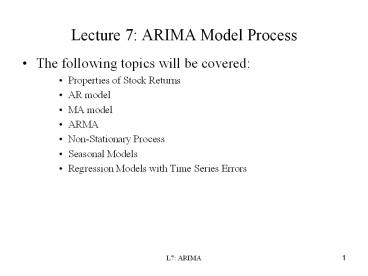Lecture 7: ARIMA Model Process PowerPoint PPT Presentation
1 / 19
Title: Lecture 7: ARIMA Model Process
1
Lecture 7 ARIMA Model Process
- The following topics will be covered
- Properties of Stock Returns
- AR model
- MA model
- ARMA
- Non-Stationary Process
- Seasonal Models
- Regression Models with Time Series Errors
2
Time Series Plot
data msi set crsp.msi mretvwretd
mno(year(date)-1930)12month(date) keep mno
mret proc gplot datamsi symbol vnone ijoin
l1 plot mretmno run
3
Basics
- Return measures
- Empirical properties of returns (page 16 Table
1.2 and Figure 1.4) - Daily returns of market indexes and individual
stocks tend to have high excess kurtoses - The standard deviation of monthly returns is
greater than the standard deviation of daily
returns - The difference between simple and log returns is
not substantial.
4
Stationarity
- A time series rt is said to be strictly
stationary if the joint distribution rt1, ,
rtk is identical to that of rt1t, , rtkt
for all t, where k is an arbitrary positive
integer. - See page 9 to 10 of RT for the definition of
joint distribution - A time series rt is said to be weakly
stationary if both the mean of rt and the
covariance between rt and rt-l are
time-invariant, where is an arbitrary integer.
That is (1) E(rt)µ - (2) Var(rt) ?0
- (3) cov(rt,
rt-l)?l
5
Correlation and Auto-correlations
6
Portmanteau Statistic
7
Alternative Time Series
8
Properties of AR Models
- Mean and Variance of AR(1)
- See page 30 derive them
- Autocorrelation Function an AR(1) model
- Mean, Variance, and ACF of AR(2) page 29
- Stationarity of AR(2)
- AR(p) model
9
AR(2)
10
Identifying AR Models
11
Estimation of AR(p)
12
Forecasting AR(p)
13
More on Forecasting AR(p)
- 2) 2-step Ahead Forecast
- See page 40 the variance of the forecast error
is Vareh(2) Model Checking If the model is
adequate, then the residual series should behave
as a white noise. The ACF and the Portmanteau
test of the residual at can be used to check
the closeness of at to a white noise. - proc arima datamsi identify varmret nlag12
- estimate p1 methodml
- forecast lead1
- run
14
Moving-Average (MA) Models
15
ARMA Models
16
Random Walk and ARIMA
- Random Walk without a Drift ptpt-1at
- Random Walk with a drift ptµpt-1at
- ARIMA page 60
17
Seasonal Models
- Seasonality of quarterly earnings
- Seasonal adjustments yt-yt-s(1-Bs)yt
- Multiplicative Seasonal Models
18
Regressions with Time Series Errors
19
Exercises
- (1) Ch 2, 6
- (2) Get quarterly earnings per share (data11)
from Quarterly Computstat file. Do the following - (a) Compute average EPS across all firms
- (b) Plot average quarterly EPS from 1996 through
2004 - (c) Plot ACF and PACF for quarterly EPS
- (d) Take seasonal difference and check ACF and
PACF again

